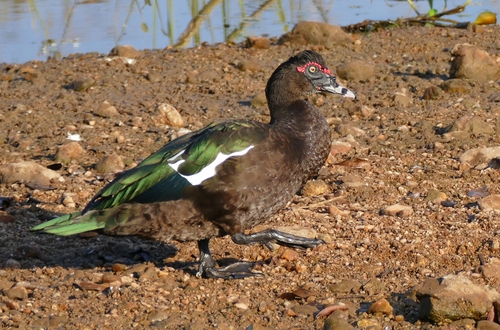
Muscovy Duck
The Muscovy Duck (Cairina moschata) is a large duck species native to Mexico, Central, and South America. Unlike most domesticated ducks, it is not derived from the Mallard. Known for its distinctive appearance, including prominent red facial wattles, the Muscovy Duck plays a significant role in its native ecosystems as both a seed disperser and a consumer of invertebrates. It has also been widely domesticated and feral populations exist worldwide, often in urban and suburban parks. In some cultures, it is valued for its meat and eggs, while in others, it is considered an ornamental bird.
66-84 cm
Length
137-152 cm
Wingspan
Least Concern
Conservation Status
Distribution
Native to Mexico, Central America, and South America as far south as Argentina and Uruguay. Feral populations are established in many parts of the world, including North America (particularly Florida), Europe, Australia, and New Zealand. They are non-migratory in their native range, though they may make local movements in response to water availability.
Lifespan
Up to 8 years in the wild, up to 12 years in captivity.
Muscovy Duck's Habitat
Habitat Types
Freshwater wetlands, Swamps, Mangrove forests, Lakes, Rivers, Agricultural areas (near water), Urban parks (with water bodies)
Climate Zones
Tropical, Subtropical, Temperate (in introduced ranges)
Adaptations
Muscovy Ducks have strong claws that allow them to perch easily in trees, a relatively unusual trait for ducks. They are also tolerant of a wide range of water conditions, from fresh to brackish.
Variations
Two subspecies are generally recognized: *Cairina moschata sylvestris* (wild Muscovy Duck) and *Cairina moschata domestica* (domesticated Muscovy Duck). Domesticated varieties exhibit a wider range of plumage colors and patterns.
Appearance
Breeding Plumage
Wild Muscovy Ducks have primarily black plumage with large white wing patches. Domesticated varieties come in a wide array of colors, including white, black, chocolate, blue, and pied patterns. There is no significant seasonal change in plumage.
Seasonal Feather Changes
Minimal seasonal variation. Molting occurs gradually.
Sex Based Plumage Differences
Males have more prominent caruncles (red fleshy growths) on the face, especially around the bill, than females.
Notable Features
Prominent red facial wattles (caruncles), Strong claws for perching, Broad, flat bill, White wing patches (in wild type)
Diet and Feeding
Primary Foods
Plant material (seeds, roots, stems), Aquatic vegetation, Small fish, Insects, Crustaceans, Mollusks, Reptiles (small), Amphibians (small)
Foraging Behavior
Muscovy Ducks dabble in shallow water, graze on land, and occasionally dive for food. They are often seen foraging in grassy areas near water.
Specializations
Their strong claws aid in gripping vegetation and navigating muddy banks. Their broad bill helps them to efficiently filter food from water and mud.
Seasonal Diet Variations
Diet may shift slightly depending on food availability, with a greater reliance on seeds and grains during drier periods.
Behavior
Social Structure
Muscovy Ducks can be found in pairs or small groups, but larger flocks may form outside of the breeding season, especially in areas with abundant food resources. Domesticated birds are often more gregarious.
Communication
Hissing sounds (especially males), Soft quacking (females), Visual displays (head bobbing, crest raising), Grunts
Migration
Generally non-migratory, although they can make local movements.
Territorial or Group Behaviors
Males can be territorial during the breeding season, defending their mates and nesting sites. Outside of breeding, they are generally less aggressive.
Conservation
Threats
Habitat loss (wetland drainage), Hunting (in some regions), Hybridization with feral Mallards (minor threat)
Protection Programs
General wetland conservation efforts benefit Muscovy Ducks.
Local National Laws
Protected under various national and international wildlife laws, but hunting may be permitted in some areas with regulations.
Population Trend
Stable
Population Estimates
The global population is estimated to be in the millions.
Interesting Facts
Muscovy Ducks are often called 'mute' ducks
This is because they do not quack like other ducks, instead making hissing and puffing sounds.
They are one of the oldest domesticated bird species
Evidence suggests they were domesticated in South America centuries before the arrival of Europeans.
Muscovy Ducks can interbreed with Mallard-derived ducks
However, the offspring (mulards or mule ducks) are sterile.
The red facial wattles are called caruncles
They are more prominent in males and can become engorged with blood during displays of aggression or courtship.
Muscovy ducks can fly fairly well
Despite their large size, they are strong fliers, although domesticated varieties are generally heavier and less agile in the air.
Faqs about Muscovy Duck
Are Muscovy Ducks aggressive?
Males can be aggressive, particularly during the breeding season. They may hiss, peck, and chase other ducks or even people who get too close to their territory or mates.
What do Muscovy Ducks eat?
They have a varied diet that includes plant material (seeds, roots, stems), aquatic vegetation, small fish, insects, crustaceans, mollusks, and even small reptiles and amphibians.
Do Muscovy Ducks make good pets?
They can be kept as pets, but they require ample space, access to water, and proper care. They can be messy and males can be aggressive.
Why are Muscovy Ducks often found in parks?
Feral populations have established themselves in many urban and suburban areas, often thriving in parks with ponds or lakes where they are sometimes fed by people.
Do Muscovy Ducks quack?
No. They are known for hisses, grunts and coos, but do not quack like mallard-derived ducks.
Copyright @ Nature Style Limited. All Rights Reserved.
 English
English